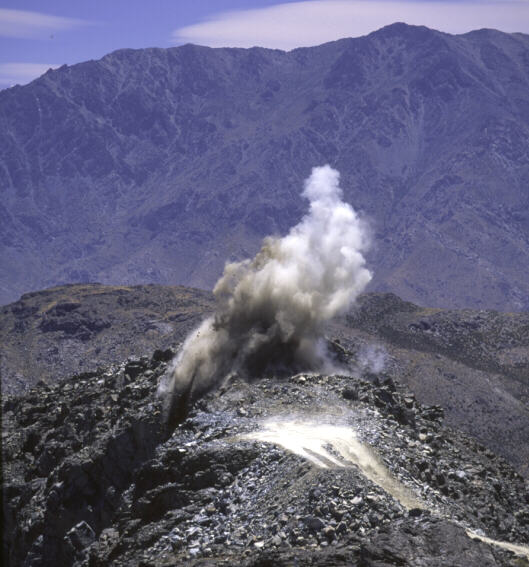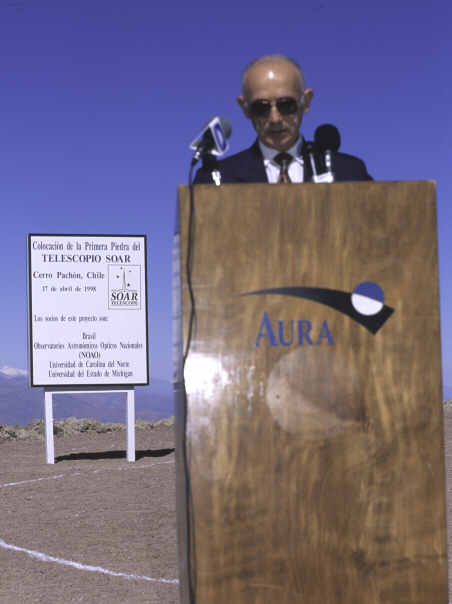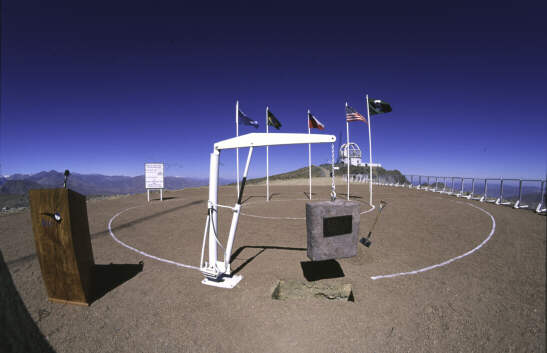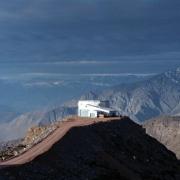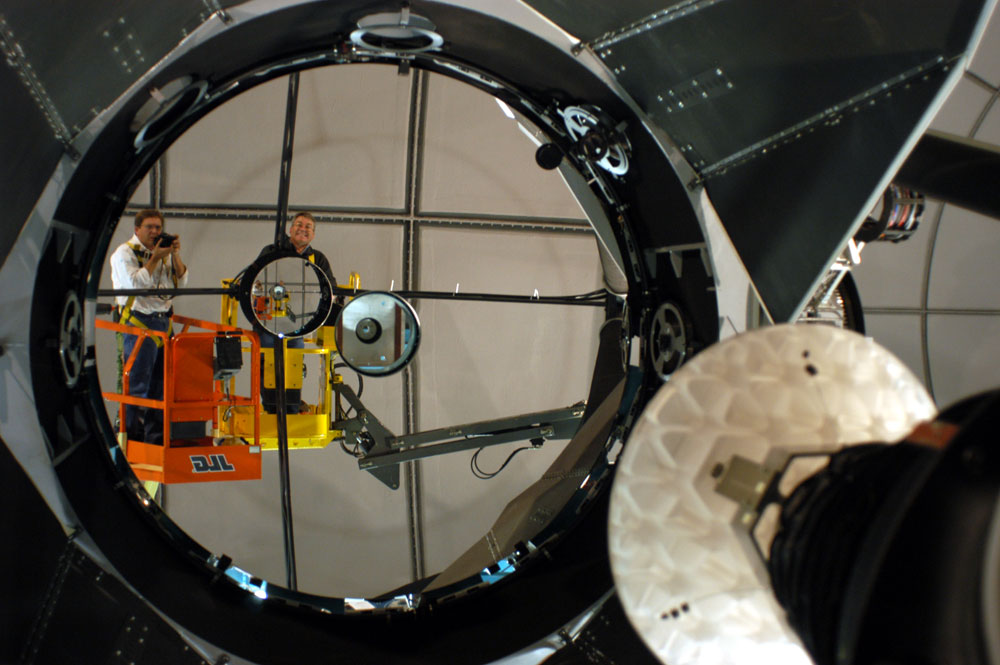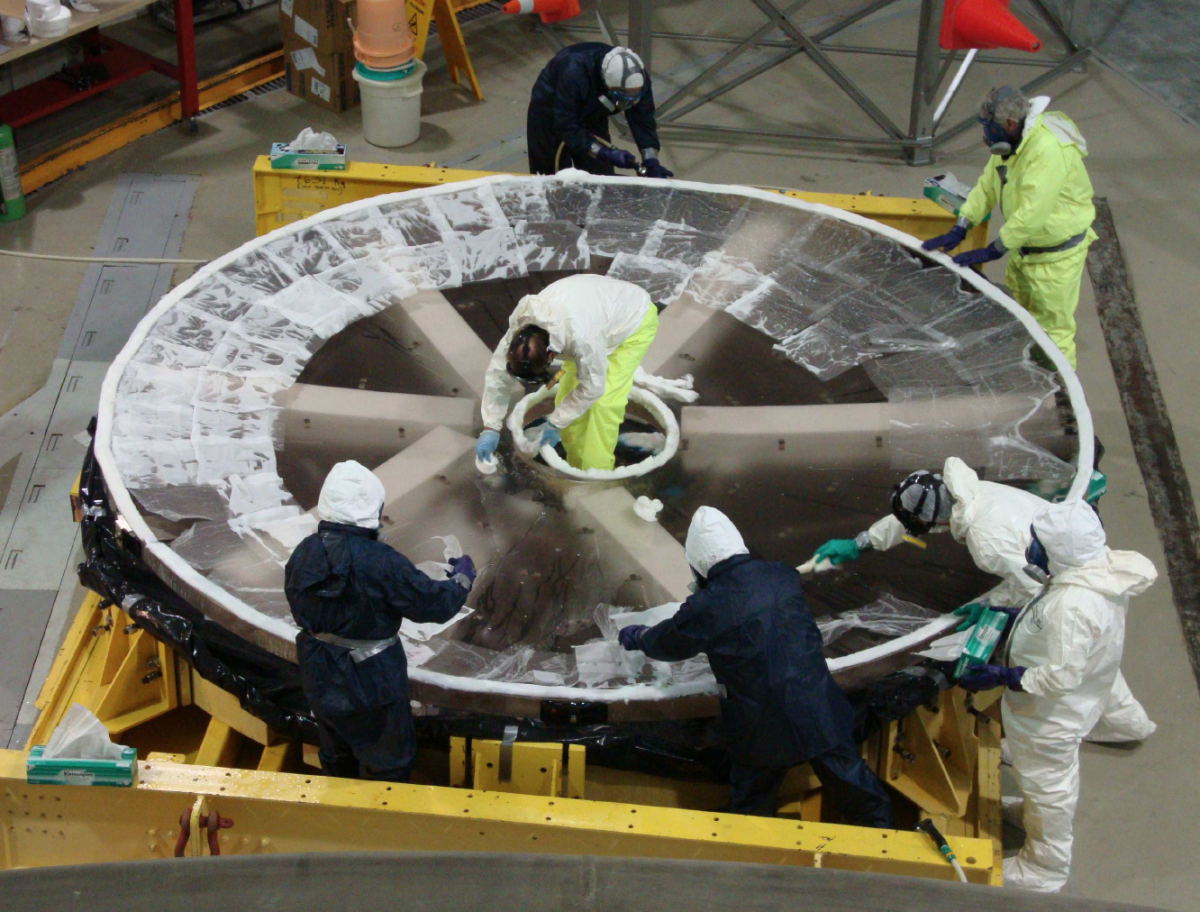History of the SOAR Telescope project
|
The SOAR Project was inititated by the University of North Carolina at Chapel Hill in 1987. Early progress included the purchase of the ULETM glass ceramic needed for the mirrors. The final project development team was formed at the beginning of 1997. The conceptual design for SOAR was approved in June 1998. The blasting for leveling of the site (shown in the picture at right) took place early that year, and the groundbreaking ceremony was held on Apr 17, 1998 (images below). |
Construction started in Jan 2000, and the support facility completed in 2001. In Oct 2002 the telescope mount was installed and completed, and the dome finished. The telescope structure was installed in only three months, becoming operational for a "first glimmer" using a 10-inch telescope bolted to the side of the elevation ring on 23 Oct 2002. The optical system was completed in 2003 and delivered to Cerro Pachón on 9 Jan 2004. The primary mirror was installed during February 2004, after being aluminized in the Gemini South coating plant nearby.
The development team was a small, multi-disciplinary group of engineers and scientists tasked with creating the telescope and facility from concept to a functional, state-of-the-art scientific machine. To develop the hardware, several fixed price contracts were awarded for the detailed design, development and testing of the particular subsystems. Innovation without research was the emphasis of the development work, encouraging contractors to adapt existing technologies to the SOAR objectives. Subsystems were preassembled at the contractor facilities and tested to the extent possible before shipment to the SOAR site, a strategy that allowed rapid integration of the parts on the remote mountain top site. Thomas A. Sebring assembled and led the project team for the first five years. Dr. Gerald Cecil was the first project scientist, supporting the critical early stages of design and development. Victor L. Krabbendam managed the final year of development and integration, in close interaction with the first SOAR Director Dr. Stephen R. Heathcote, who managed the commissioning budget. This capable team achieved SOAR's ambitious performance goals within a comparatively modest budget of US$32 million (excluding instruments).
Unfortunately, once completed and tested on-sky, a serious problem with the lateral primary mirror supports was readily identified, an issue limiting the scientific capabilities of the telescope. Despite this, first science observations with the telescope "as it was", were carried out in Feb 2005 with the SOAR Optical Imager (SOI) and the OSIRIS near-infrared spectrograph. A new lateral support system which solved the problem was installed in Jun 2006, and regular science observations started Aug 2006.
In 2008 the Goodman High-Throughput Spectrograph (GHTS) was delivered to the telescope and commissioned. This is a highly configurable imaging spectrograph, that has become the workhorse instrument at SOAR. It produces images across around 7.2 arcmin diameter field, and in spectroscopic mode has several 3.5 arcmin long slits, from 0.45 to 10 arcsec wide, that combined with an assortment of gratings provides resolutions spanning from R~400 to R~12000. The GHTS can also operate in Multi-Object Slit (MOS) mode. Spectroscopic single slit and imaging mode observations with this instrument started in late 2008. In Oct/Nov 2009 a major shutdown took place for the recoating of all the optics.
In early 2010 the SPARTAN near-IR camera, built at Michigan State University was commissioned and started seeing regular scientific use. It has four "Hawaii-II" 2048x2048 pixel HgCdTe detectors. It is run at f/12, yielding offers a field of view of 5.04 x 5.04 arcmin at a scale of 0.066 arcsec/pixel.
In 2013 the SOAR Adapative Optics Module (SAM), built at CTIO, was commissioned and released for regular scientific use at the beginning of 2014. SAM is a laser-assisted adaptive optics system. By compensating selectively low-altitude turbulence sensed by a UV laser guide-star, it improves resolution at visible wavelengths. SAM contains a 4Kx4K CCD imager covering the 3-arcmin square field.
Since 2018 the SOAR Integral Field Spectrograph (SIFS) has been offered to users on a regular basis, operated in campaign mode. SIFS was comissioned in late 2017 and science verification was carried out in 2017A. This instrument was developed and constructed in Brazil for the 4.1-m SOAR telescope by the Laboratório Nacional de Astrofísica (LNA/MCTIC) in collaboration with the Instituto de Astronomia, Geofísica e Ciências Atmosféricas, Universidade de São Paulo (Institute of Astronomy, Geophysics and Atmospheric Sciences of the University of São Paulo, IAG/USP).
During the 2019A semester, the TripleSpec4.1 near-IR spectrograph, first commisioned on the CTIO 4-m Blanco telescope as ARCoIRIS, was moved over to SOAR, thus providing greater community access to this instrument. TripleSPec4.1 is a cross-dispersed, single-object, longslit, near infrared imaging spectrograph, containing no moving parts; it is based on an updated design of the three existing TripleSpec spectrographs installed on the 3.5m telescope at Apache Point Observatory, the 5m Hale telescope at Palomar Observatory, and on the 10m Keck II telescope on Maunakea. TripleSPec4.1 features a fixed slit assembly of 1.1-arcsecs by 28-arcsecs. Spectra cover a simultaneous wavelength range of 0.80 to 2.47 microns, at a spectral resolution of approx. 3500, encompassing the entire z'YJHK photometric range. TSpec replaced the OSIRIS
Starting the 2019B semester, SOAR and NOIRLab have been offering a new observing mode at SOAR, the SOAR-AEON dynamic queue system. The Astronomical Event Observatory Network (AEON) is a facility ecosystem for accessible and efficient follow up of astronomical transients and Time Domain science. At the heart of the network, NOIRLab, with its SOAR 4.1m and Gemini 8m telescopes (and the CTIO Blanco 4m to be added later), has joined forces with Las Cumbres Observatory to build such a network for the era of the Legacy Survey of Space and Time (LSST). SOAR is the pathfinder facility for incorporating the 4m and 8m class telescopes into AEON. This mode offers both imaging and low resolution spectroscopy with the GHTS as a regular capability. In addition to dynamic, programmatically accessible scheduling, AEON on SOAR provides a web-based real-time spectroscopic data reduction pipeline, which allows our Goodman spectrograph users to get 1-dimensional, wavelength-calibrated spectra just seconds after the raw data have been written to disk, all on their web browser, without the need to download any software.
During the period Mar-Jul 2014 Dr. Horacio Dottori (Universidade Federal do Rio Grande do Sul, Brazil) acted as interim Director. Dr. Jay Elias (NSF´s NOIRLab) has been SOAR Director since August 2014.

Updated on June 18, 2024, 5:43 am
